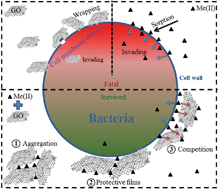当前位置:
X-MOL 学术
›
Environ. Sci.: Nano
›
论文详情
Our official English website, www.x-mol.net, welcomes your
feedback! (Note: you will need to create a separate account there.)
Graphene oxide interactions with co-existing heavy metal cations: adsorption, colloidal properties and joint toxicity†
Environmental Science: Nano ( IF 5.8 ) Pub Date : 2017-11-28 00:00:00 , DOI: 10.1039/c7en01012e Yang Gao 1, 2, 3, 4, 5 , Xuemei Ren 1, 2, 3, 4, 5 , Jianchun Wu 5, 6, 7, 8 , Tasawar Hayat 9, 10, 11, 12 , Ahmed Alsaedi 9, 10, 11, 12 , Cheng Cheng 1, 2, 3, 4, 5 , Changlun Chen 1, 2, 3, 4, 5
Environmental Science: Nano ( IF 5.8 ) Pub Date : 2017-11-28 00:00:00 , DOI: 10.1039/c7en01012e Yang Gao 1, 2, 3, 4, 5 , Xuemei Ren 1, 2, 3, 4, 5 , Jianchun Wu 5, 6, 7, 8 , Tasawar Hayat 9, 10, 11, 12 , Ahmed Alsaedi 9, 10, 11, 12 , Cheng Cheng 1, 2, 3, 4, 5 , Changlun Chen 1, 2, 3, 4, 5
Affiliation

|
To find the linkage among the surface adsorption, colloidal stability and combined toxicity of graphene oxide (GO) and divalent heavy metal cations (denoted as Me(II)), the adsorption affinity of GO and bacteria towards Me(II) (i.e., Cd2+, Co2+ and Zn2+), the destabilizing ability of Me(II) on GO, and the combined effects of GO and Me(II) on the survival of Gram-negative Escherichia coli (E. coli) and Gram-positive Staphylococcus aureus (S. aureus) bacteria were investigated. The results show that the destabilizing ability of Me(II) is consistent with their adsorption affinity with GO, which is positively correlated with the ionic radius of Me(II) and negatively correlated with the hydration shell thickness of Me(II). Moreover, the adsorption affinity of bacteria towards Me(II) is negatively correlated with the toxicity of Me(II). Reasons causing the decreased joint toxicity of GO and Me(II) are (1) GO decreases the amount of free Me(II) ions by adsorption; (2) Me(II) change the size and edge sharpness of GO by complexation; (3) GO competes with Me(II) for the membrane receptor binding sites; (4) GO–Me(II) complexes cannot be assimilated by bacteria; (5) Me(II) change the surface properties of GO and bacteria, consequently affecting their interactions. These findings are important for the assessment of the ecological risk of GO after it was used as a heavy metal ion carrier.
中文翻译:

氧化石墨烯与共存的重金属阳离子的相互作用:吸附,胶体性质和联合毒性†
为了找到氧化石墨烯(GO)和二价重金属阳离子(表示为Me(II))的表面吸附,胶体稳定性和组合毒性之间的联系,GO和细菌对Me(II)(即Cd )的吸附亲和力2+,Co 2+和Zn 2 +),Me(II)对GO的去稳定能力以及GO和Me(II)对革兰氏阴性大肠杆菌(E. coli)和Gram存活的联合作用对金黄色葡萄球菌(S. aureus)阳性细菌进行了研究。结果表明,Me(II)是与GO它们的吸附亲合性,这是正与我的(离子半径相关的一致II)和带负与我(水合壳厚度相关II)。此外,细菌对我(吸附亲和力II)是负我(的毒性相关的II)。导致GO和Me(II)的联合毒性降低的原因是:(1)GO通过吸附减少了游离Me(II)离子的量;(2)Me(II)通过络合改变GO的大小和边缘清晰度;(3)GO与Me(II)竞争膜受体结合位点;(4)GO–Me(II)复合物不能被细菌吸收;(5)Me(II)改变GO和细菌的表面性质,从而影响它们的相互作用。这些发现对于将GO用作重金属离子载体后评估其生态风险非常重要。
更新日期:2017-11-28
中文翻译:

氧化石墨烯与共存的重金属阳离子的相互作用:吸附,胶体性质和联合毒性†
为了找到氧化石墨烯(GO)和二价重金属阳离子(表示为Me(II))的表面吸附,胶体稳定性和组合毒性之间的联系,GO和细菌对Me(II)(即Cd )的吸附亲和力2+,Co 2+和Zn 2 +),Me(II)对GO的去稳定能力以及GO和Me(II)对革兰氏阴性大肠杆菌(E. coli)和Gram存活的联合作用对金黄色葡萄球菌(S. aureus)阳性细菌进行了研究。结果表明,Me(II)是与GO它们的吸附亲合性,这是正与我的(离子半径相关的一致II)和带负与我(水合壳厚度相关II)。此外,细菌对我(吸附亲和力II)是负我(的毒性相关的II)。导致GO和Me(II)的联合毒性降低的原因是:(1)GO通过吸附减少了游离Me(II)离子的量;(2)Me(II)通过络合改变GO的大小和边缘清晰度;(3)GO与Me(II)竞争膜受体结合位点;(4)GO–Me(II)复合物不能被细菌吸收;(5)Me(II)改变GO和细菌的表面性质,从而影响它们的相互作用。这些发现对于将GO用作重金属离子载体后评估其生态风险非常重要。











































 京公网安备 11010802027423号
京公网安备 11010802027423号